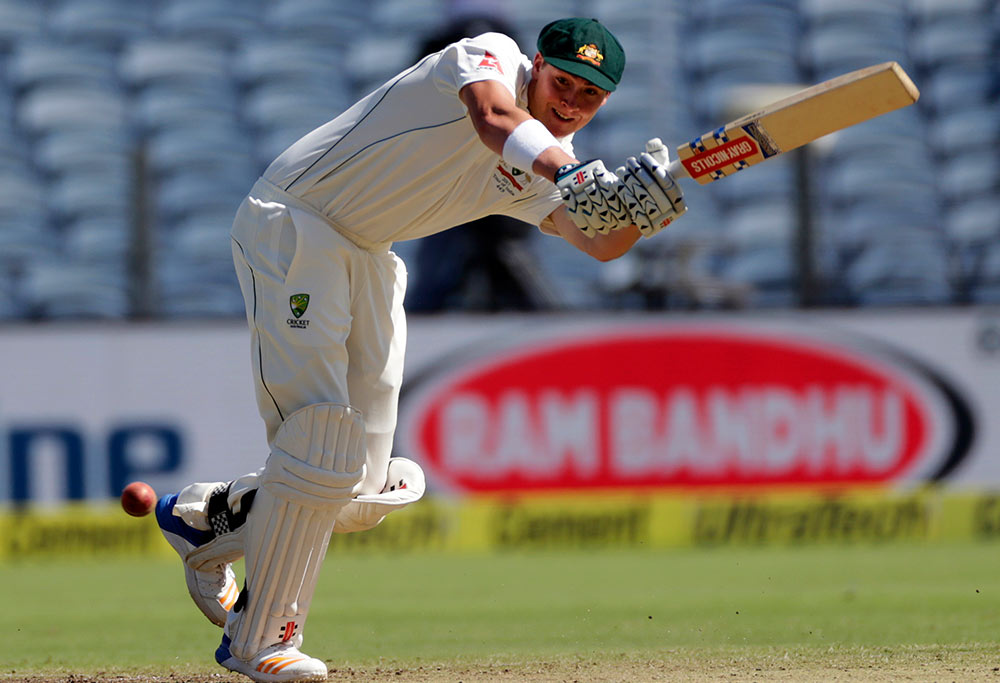Australia should fly in-form opener Matt Renshaw to South Africa for the third Test, which starts in ten days’ time, after Cameron Bancroft failed again in the second match yesterday.
Bancroft was fortunate to retain his starting spot for this tour after an underwhelming debut series in the Ashes and now, averaging 27 from seven Tests, has become a weakness Australia cannot continue to possess.
The West Australian has had his technique picked apart by first England and now the Proteas.
Meanwhile, with three centuries in his past three Sheffield Shield matches, Renshaw has well and truly banished the awful form which saw dumped for the Ashes.
The 21-year-old opener had a sensational start to his Test career but then made himself virtually unselectable for the Ashes by averaging just 14 with the bat in 16 first-class innings leading up to the first Test.
Since then, however, Renshaw has run roughshod over the Shield competition, piling up 583 runs at 73. Further underlining how greatly his form has shifted is the fact Renshaw’s strike rate in his last five Shield matches has been 58, compared to his glacial rate of 28 in his first four games this season.
During this latter period, Renshaw has showcased multiple gears to his batting, often starting slowly before taking attacks apart once set. This was an aspect of his batting which needed to improve during his ten-match stint in the Test team.

(AP Photo/Rajanish Kakade)
The other key area Renshaw needed to hone was his batting against right-arm quicks from around the wicket. He was first exposed by this bowling tactic in the Tests in India last year, when the home pacemen began using this angle as the series wore on.
Up to that point of his Test career, Renshaw’s success had been built on his discipline in leaving balls outside off stump. This forced bowlers to straighten their line, often earning Renshaw the leg side flicks which helped get him going early in his innings.
Once these right-armers changed their angle to around the wicket Renshaw’s judgment became cloudy and he was repeatedly found out, prodding at and edging wide deliveries which could easily have been left alone.
The quicks in the Shield have not abandoned this tactic, Renshaw has just managed to rid himself of the tendency to fish for those wider offerings.
While many cricket fans are adamant Renshaw should never have been dropped from the Test team, I would argue he has benefited immensely from his stint in the Shield. The left-hander had significant issues to iron out and was able to do that away from the blinding glare of an Ashes contest.
He now looks primed to return to international cricket for the third Test in Cape Town, which is traditionally a very pace-friendly venue. With his generous patience and ability to blunt the new ball, Renshaw always shaped as the perfect opening partner for the dynamic David Warner.
Renshaw’s circumspection and willingness to bat for time also meshes with Australia’s new cautious approach to Test batting, a strategy which has served them well over the past year.
As much has been evident since his Test debut, when he batted for 183 balls for the match while being dismissed just once on what was a juicy deck against an in-form Proteas attack.
While Renshaw has a solid defence at the core of his game, that is the area which Bancroft most needs to improve. At just 25 years of age, the West Australian has ample time to achieve this. But, like Renshaw before him, he would be best seeking this improvement while playing State cricket.
[latest_videos_strip category=”cricket” name=”Cricket”]
Meanwhile, Usman Khawaja eased concerns about his form with a dogged innings of 75 yesterday.
The left-hander had to scrap hard for his runs, and was worked over by Proteas quicks Kagiso Rabada and Lungi Ngidi early in his knock.
But Khawaja remained patient and grinded his way to his most important innings since his sublime 145 against South Africa in Adelaide 16 months ago.
Particularly encouraging was the assured manner in which Khawaja tackled in-form spinner Keshav Maharaj. Khawaja alternately used his feet confidently against the finger spinner, got deep into his crease to cut Maharaj, and even flicked a reverse sweep to the boundary.
At the other end, all-rounder Mitch Marsh constructed yet another mature and patient innings, continuing his extraordinary transformation as a Test cricketer. Marsh once more set tight parameters within which he operated, limiting risk and focusing on batting for time.
Since returning to the Test team three months ago, Marsh has piled up 465 runs at 77. Yet, despite his fine work alongside Khawaja in the last session yesterday, he will need to kick on today if Australia are to bat their way back into this Test.
After offering disconcerting seam movement on day one, the Port Elizabeth pitch has settled down to become a good track for batting. Australia will need to swell their current lead of 41 to beyond 150 if they are to put any pressure on the hosts.






























































































